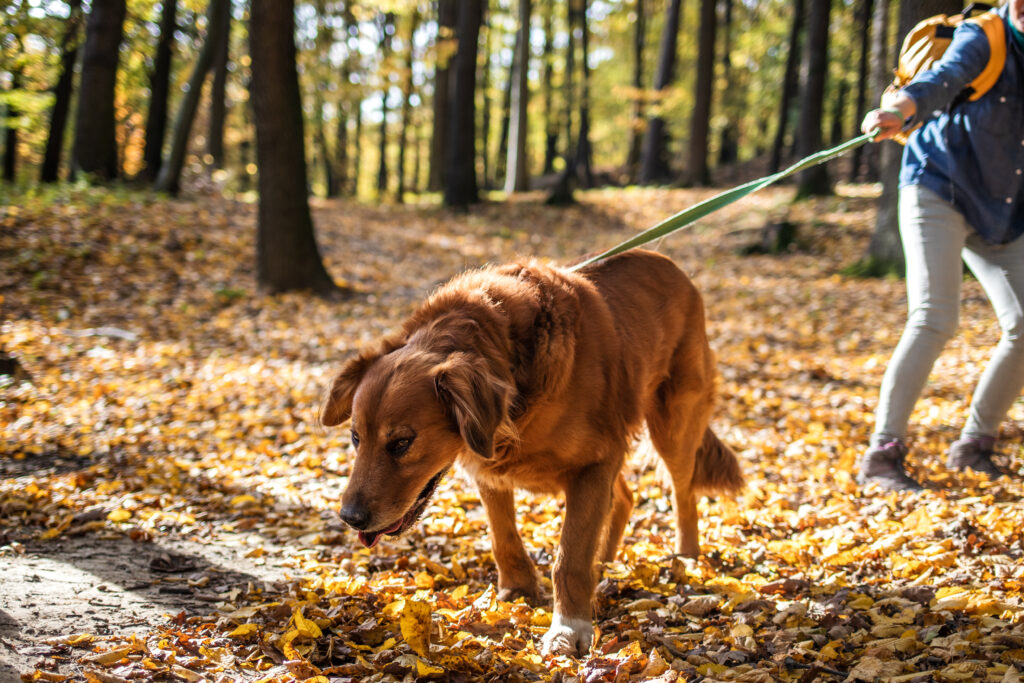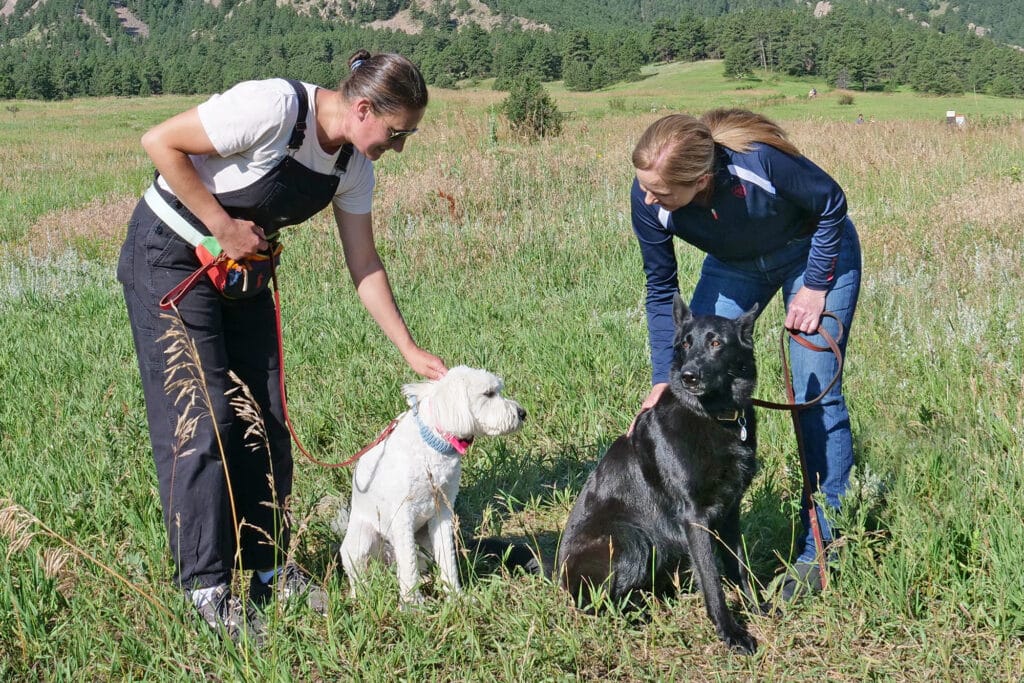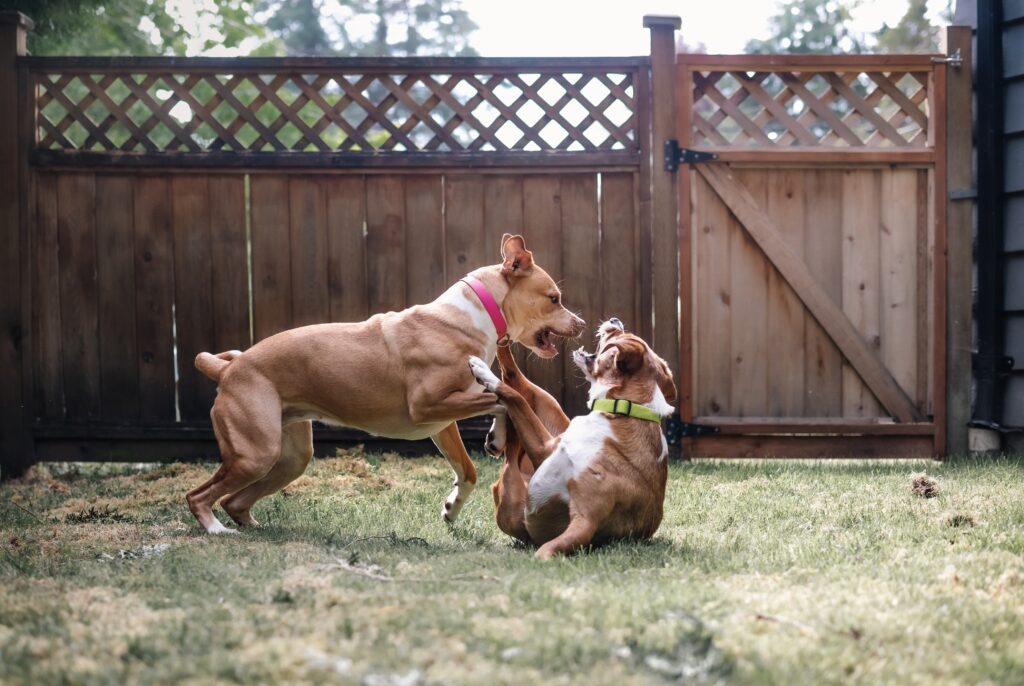Everything to Know About Dominance in Dogs
Have you ever wondered if your dog is trying to be the “alpha”? Perhaps you’ve been told your dog pulls on the leash because they’re trying to dominate you, or that they won’t listen because they see themselves as the pack leader. This traditional view of dominance in dogs has been widely accepted for decades, but it’s fundamentally flawed.
As modern, certified dog trainers in Boulder, the team at BlackPaw Dog Training knows that what is often labeled as problematic dominant behavior in dogs is actually rooted in simple, fixable issues: lack of clear communication, poor training, anxiety, or excitement.
The goal is not to be the “boss,” but to be a consistent, trusted leader. By reframing the issue and using positive, science-backed methods, you can build a better bond and achieve lasting behavioral change.
What is Dominance in Dogs? Our Modern Take.
The term “dominance” has historically clouded the way dog owners view and train their pets, leading to misunderstanding and conflict. At BlackPaw Dog Training, we emphasize that to solve problematic behavior, we first need to understand the true science of canine social dynamics, not the myths.
Debunking the "Alpha Dog" Theory
The entire concept of the “alpha dog” originated from flawed studies in the 1970s involving unrelated, captive wolves. When these stressed wolves were forced to cohabitate, they fought to establish a hierarchy.
Decades of research on wild wolf packs have since shown they operate as family units, led by a breeding pair (the parents), with the rest of the pack being their offspring. The younger wolves naturally defer to their parents—it’s a dynamic of parental guidance, not forceful domination.
Crucially, dogs are not wolves, and they certainly don’t form rigid pack structures with humans. Modern behavioral science confirms: Your dog is not trying to dominate you or take over your house.
Dominance is a Resource Relationship, Not a Personality Trait
In animal behavior (ethology), dominance is not a character trait like “friendly” or “shy.” It is a relationship between two specific individuals over a specific resource at a specific time. For example, Dog A might be dominant over Dog B regarding a high-value bone, but Dog B might be dominant over Dog A regarding the best spot on the bed.
These relationships are fluid and established through ritual and deference, not constant fighting. Most conflicts between dogs and humans are a result of miscommunication and the dog being rewarded for unwanted behavior, not a complex quest for social status.
Is Dominant Behavior in Dogs a Problem?
Yes, behaviors that people label as dominant behavior in dogs are definitely problems—but not because your dog wants to rule the world. Instead, these actions are red flags that your dog is confused, anxious, or simply lacks the necessary skills to navigate the human world politely. They are problems because they indicate a lack of key skills or a state of anxiety that can lead to unsafe situations.
Reframing the Issue: From Dominance to Lack of Skills
Yes, behaviors that people label as dominant behavior in dogs are definitely problems—but not because your dog wants to rule the world. They are problems because they indicate a lack of key skills or a state of anxiety that can lead to unsafe situations.
| Misconception | Problem Behavior | Underlying Cause |
|---|---|---|
| "The dog is dominant." | Resource Guarding | Anxiety over losing a valued item. |
| "The dog is stubborn." | Pulling on Leash | Excitement/Lack of impulse control |
| "The dog is being pushy." | Ignoring Commands | Lack of consistent training or low motivation. |
A dog that is pushy or disobedient simply needs clearer rules and consistent guidance from a trusted leader. Misreading a dog’s signals can make things worse; you can learn more by viewing our dog body language chart.
The Dangers of "Being the Boss"
The most harmful advice stemming from the dominance myth is the use of confrontational training methods. Techniques like “alpha rolls,” physical corrections, or staring down your dog do not create respect; they create fear.
When an owner uses force:
- Trust is Broken: The dog learns that its human is unpredictable and potentially dangerous.
- Aggression is Elicited: The dog will often respond defensively, increasing the risk of a bite.
- Warning Signals are Suppressed: If you punish a growl (a warning signal), the dog may skip that warning next time and go straight to a bite. Understanding fear and its role in training is essential to avoid this dangerous outcome.
A modern leader teaches through positive reinforcement, not intimidation.
The Top 5 Signs of Dominance in Dogs (And What They Really Are)

If you are looking for the signs of dominance in a dog, here are the common behaviors that people often misunderstand, along with their true causes and modern, positive solutions:
1. Resource Guarding (Growling over food, toys, or space)
- Behavior Often Called “Dominance”: When a dog growls, snaps, or freezes near a resource (like a bone or a bed), owners often assume they are establishing control or “dominance.”
- Real Cause & Modern Solution: This behavior is almost always rooted in anxiety. The dog fears losing something valuable and is communicating that fear. The Solution is to practice positive counter-conditioning. Teach your dog that a human approaching actually means something better (like a high-value trade) or that you are not a threat to the resource.
2. Pulling on the Leash/Barging Doors
- Behavior Often Called “Dominance”: The dog rushing out the door first or pulling hard on the leash is often seen as the dog attempting to lead or take control of the walk.
- Real Cause & Modern Solution: This stems from excitement or a lack of impulse control. The dog has not been taught that the human controls access to the exciting world outside. The solution is to teach loose-leash walking skills and require a “sit” or “wait” before opening any door. This establishes the human as the reliable manager of the environment.
3. Humping (Mounting)
- Behavior Often Called “Dominance”: Humping people, objects, or other dogs is frequently mislabeled as a primary show of dominance.
- Real Cause & Modern Solution: This behavior is most often a displacement activity stemming from stress, over-arousal, or excitement, or it can be a learned attention-seeking behavior. It is rarely about dominance toward a human. The solution is to immediately interrupt the behavior and redirect the dog to a calming activity or a specific command like “place” or “down.”
4. Stealing/Refusing to Give Up Items
- Behavior Often Called “Dominance”: The dog running away with a stolen item or refusing to drop a toy when commanded is viewed as disobedience driven by the desire for control.
- Real Cause & Modern Solution: This reflects a lack of a reliable command. The dog doesn’t have a solid “Drop It” command that has been consistently reinforced with high-value rewards. The solution is to practice “Drop It” using a positive trade system where the dog always gets something great (a better toy or treat) for willingly giving up an item.
5. Pawing/Leaning/Jumping on People
- Behavior Often Called “Dominance”: The dog demanding physical contact or jumping on the human is sometimes misinterpreted as being “pushy” or dominating the human’s space.
- Real Cause & Modern Solution: This is a learned attention-seeking behavior. The dog has been accidentally rewarded (even by a push-off, or a stern “No!”) for using physical contact. The solution is to strictly ignore all pawing/jumping. Only reward the dog when they offer a calm, desired behavior like a “sit” or “down” for attention.
Tips for Training Away Problematic Behavior
Effective training when it comes to dominance in dogs is all about establishing yourself as a source of safety, predictability, and positive outcomes, not as a dictator.
Be Consistent, Not Confrontational
The secret to a well-behaved dog is consistency. If you allow your dog on the couch sometimes but not others, they become confused, and that confusion can lead to conflict. Set clear, simple rules and enforce them 100% of the time. This reliability builds trust.
Utilize Positive Reinforcement
Positive reinforcement training is based on the idea that behaviors that are rewarded are repeated. Instead of focusing on what your dog did wrong, focus on rewarding the behaviors you want to see. Use high-value rewards to teach skills like “Leave It” and “Wait” at the food bowl or the door. These exercises teach your dog to pause their natural instinct and look to you for guidance.
Build a Bond of Trust
Focus on relationship-building activities that your dog enjoys—like structured play, puzzle toys, and fun training sessions—to strengthen your bond. When your dog sees you as the provider of all good things and the reliable source of safety, their desire to cooperate naturally increases.
When to Call a Certified Professional Dog Trainer in Boulder
While many minor behaviors can be corrected with consistency and positive reinforcement, some issues require professional intervention. As Boulder dog trainers, the team at BlackPaw Dog Training specializes in addressing complex issues like dominance in dogs.
Escalating or Risky Behavior
If you observe aggressive behavior that includes biting, breaking the skin, or frequently escalating to lunging and snapping, you need professional help immediately. This is particularly true if the behavior is directed at family members or guests. A certified trainer will assess the root cause (often fear or anxiety) and create a behavior modification plan to ensure safety. These deep-rooted issues may require specialized training for fear-aggressive dogs.
You've Tried and Failed to Make Progress
If you have been consistent with positive training for several weeks and are seeing no improvement, or if the behavior is getting worse, don’t wait. A professional can quickly identify what you are missing—whether it’s the wrong reward, poor timing, or misreading your dog’s stress signals. For dogs requiring rapid, focused intervention, BlackPaw Dog Training offers programs where intensive dog training can provide the necessary structure and consistency.
The Importance of Certification
When seeking help, look for a trainer with certifications (such as CPDT-KA or behavior consultants with IAABC accreditation) who uses modern, force-free, and science-based methods. This ensures the training will be effective, humane, and designed to address the behavior’s cause, not just suppress the symptom. The experts at BlackPaw Dog Training uphold these standards to protect your dog’s welfare and your relationship.
Lafayette and Boulder Dog Training for Your Pup

The myth of dominance in dogs has caused countless owners to use ineffective and damaging training methods. The truth is simple: your dog does not need you to be an “alpha.” Your dog needs you to be a fair, reliable, and loving leader who communicates clearly and rewards good behavior consistently.
By shifting your focus from dominance to positive, skills-based training, you will eliminate problematic behaviors, strengthen your bond, and enjoy a confident, well-behaved canine companion.
Ready to stop battling for control and start building a trusting partnership? Contact BlackPaw Dog Training today for a personalized consultation on addressing your dog’s behavioral issues with positive, effective methods right here in the Boulder area.

